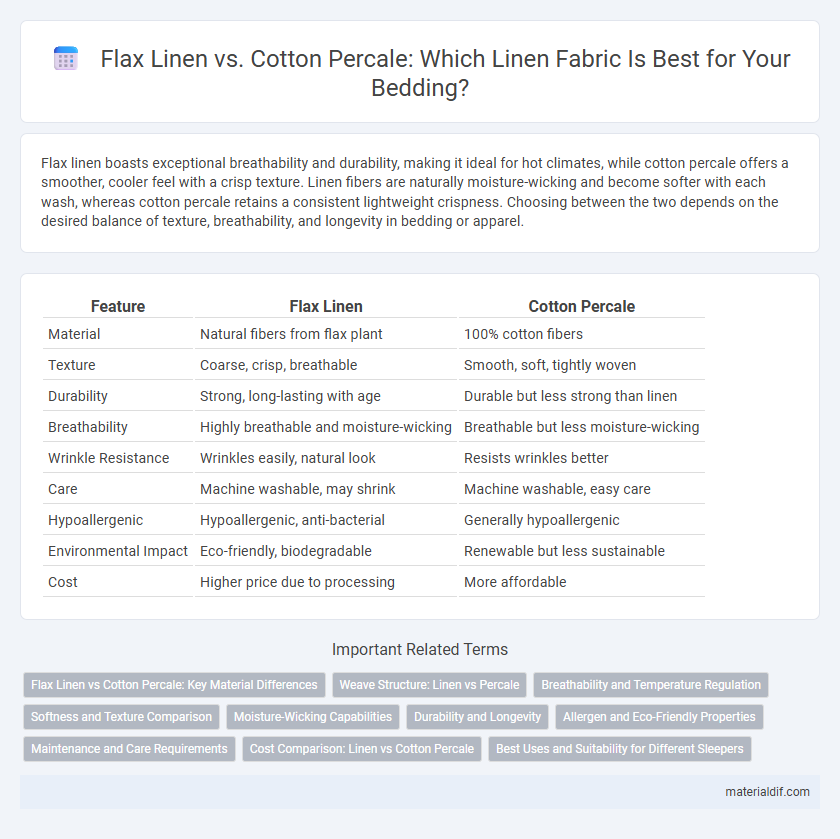Flax linen boasts exceptional breathability and durability, making it ideal for hot climates, while cotton percale offers a smoother, cooler feel with a crisp texture. Linen fibers are naturally moisture-wicking and become softer with each wash, whereas cotton percale retains a consistent lightweight crispness. Choosing between the two depends on the desired balance of texture, breathability, and longevity in bedding or apparel.
Table of Comparison
| Feature | Flax Linen | Cotton Percale |
|---|---|---|
| Material | Natural fibers from flax plant | 100% cotton fibers |
| Texture | Coarse, crisp, breathable | Smooth, soft, tightly woven |
| Durability | Strong, long-lasting with age | Durable but less strong than linen |
| Breathability | Highly breathable and moisture-wicking | Breathable but less moisture-wicking |
| Wrinkle Resistance | Wrinkles easily, natural look | Resists wrinkles better |
| Care | Machine washable, may shrink | Machine washable, easy care |
| Hypoallergenic | Hypoallergenic, anti-bacterial | Generally hypoallergenic |
| Environmental Impact | Eco-friendly, biodegradable | Renewable but less sustainable |
| Cost | Higher price due to processing | More affordable |
Flax Linen vs Cotton Percale: Key Material Differences
Flax linen is derived from the flax plant fibers, offering superior breathability, moisture-wicking properties, and natural hypoallergenic qualities compared to cotton percale, which is woven from tightly-spun cotton fibers for a smoother, crisper texture. While linen features a more durable, textured surface that softens over time and resists pilling, cotton percale provides a lightweight, matte finish with consistent weave density ideal for cooler climates. The inherent irregularities in flax fibers create enhanced airflow and temperature regulation, distinguishing linen as the preferred choice for hot and humid environments over the denser, less porous cotton percale.
Weave Structure: Linen vs Percale
Flax linen features a plain weave structure characterized by a looser, more open texture that enhances breathability and moisture absorption. Cotton percale uses a tighter, closely woven plain weave, producing a smooth, crisp surface with greater durability. The contrasting weave densities influence the fabric's feel, temperature regulation, and longevity, making flax linen ideal for warm climates and cotton percale preferable for crisp, wrinkle-resistant bedding.
Breathability and Temperature Regulation
Flax linen offers superior breathability compared to cotton percale due to its natural fiber structure that promotes better air circulation and moisture-wicking properties. This enhanced airflow helps regulate body temperature effectively, keeping you cool in hot weather and warm during cooler nights. Cotton percale, while breathable, lacks the same level of moisture management, making flax linen a preferred choice for optimal thermal comfort and freshness.
Softness and Texture Comparison
Flax linen offers a natural, slightly coarse texture that softens with each wash, providing a breathable and lightweight feel ideal for warm climates. Cotton percale features a crisp, smooth finish with a tight weave that feels cool and silky against the skin, maintaining a consistent softness right out of the box. While linen excels in durability and moisture-wicking properties, cotton percale is favored for its initial softness and wrinkle-resistant surface.
Moisture-Wicking Capabilities
Flax linen boasts superior moisture-wicking properties compared to cotton percale, efficiently drawing moisture away from the skin to promote cooler, drier sleep. Its natural fibers allow enhanced breathability and quicker evaporation, which reduces sweat accumulation during warm nights. Cotton percale, while breathable, tends to retain more moisture, making flax linen the preferred choice for optimal moisture management in bedding.
Durability and Longevity
Flax linen outperforms cotton percale in durability due to its strong, naturally resilient fibers that withstand wear and tear over time. The texture of linen fibers allows them to maintain structural integrity and resist pilling, ensuring longevity after multiple washes. Cotton percale, while soft and breathable, tends to degrade faster with frequent laundering and shows signs of thinning and fading sooner than flax linen.
Allergen and Eco-Friendly Properties
Flax linen is naturally hypoallergenic and resistant to dust mites and bacteria, making it ideal for sensitive skin and allergy sufferers compared to cotton percale. Linen requires fewer pesticides and less water during cultivation, significantly reducing its environmental footprint relative to cotton. Its durability also extends the fabric's lifespan, contributing to sustainable textile consumption.
Maintenance and Care Requirements
Flax linen requires gentle washing in cool water and air drying to preserve its natural fibers, whereas cotton percale can withstand higher temperatures and machine drying without damage. Linen tends to wrinkle more easily and benefits from light ironing while damp, unlike cotton percale, which resists wrinkles better and often needs less frequent pressing. Both fabrics improve softness with each wash, but linen demands more delicate maintenance to prevent fiber weakening over time.
Cost Comparison: Linen vs Cotton Percale
Flax linen typically costs more than cotton percale due to the labor-intensive harvesting process and natural durability of flax fibers. Cotton percale is more affordable, benefiting from large-scale production and faster growing cycles. The higher price of flax linen often reflects its superior breathability and strength, making it a long-term investment compared to the generally cheaper and softer cotton percale.
Best Uses and Suitability for Different Sleepers
Flax linen offers superior breathability and moisture-wicking properties, making it ideal for hot sleepers who need temperature regulation and a cool, dry sleep environment. Cotton percale provides a crisp, lightweight feel with excellent softness and durability, well-suited for those who prefer a smooth texture and moderate warmth. Sleepers with sensitive skin may benefit from linen's natural hypoallergenic qualities, while cotton percale excels in easy maintenance and wrinkle resistance for everyday use.
Flax Linen vs Cotton Percale Infographic

 materialdif.com
materialdif.com